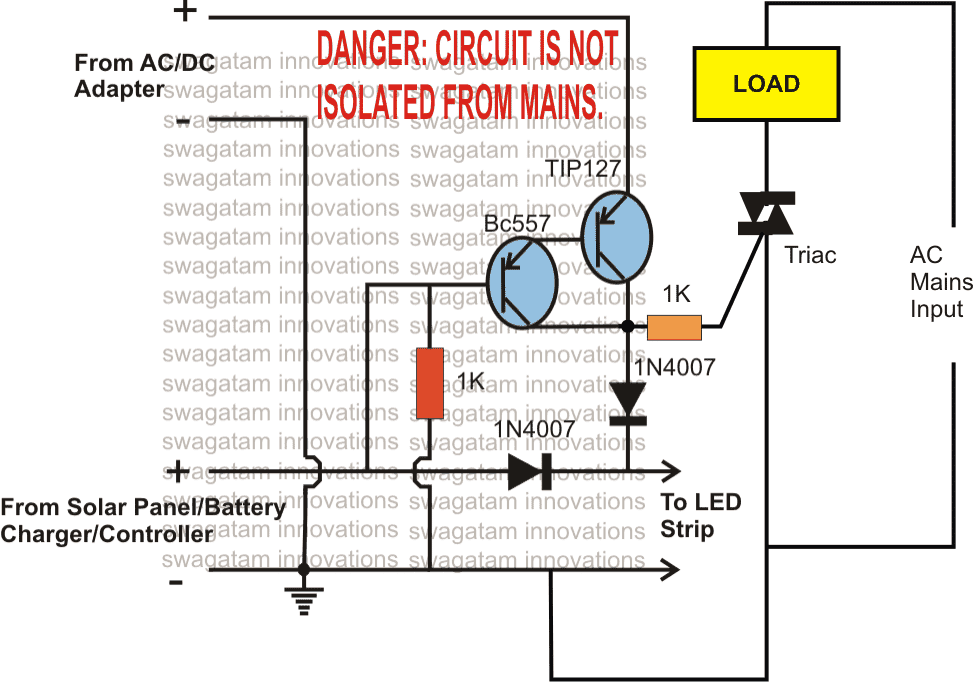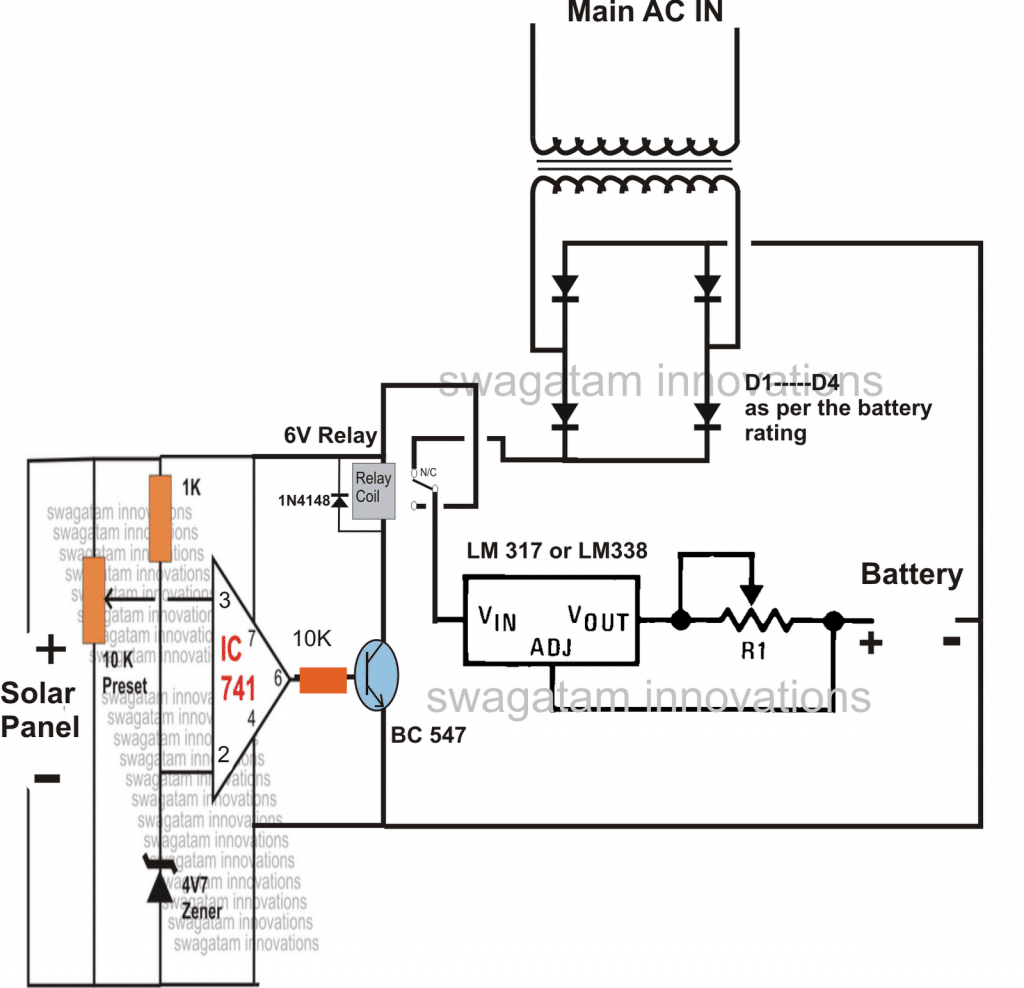The discussed automatic change over relay circuit was requested by Mr.Karimulla Baig. The circuit normally charges the connected battery at constant current through the power received from the solar panel, and reverts to DC power from an AC/DC adapter in the absence of solar energy (during night time). Let's the read the request in more details:
Technical Specifications
Please help me in designing the change over circuit for my battery charger. where i want to charge my 6V 4.5Ah battery from solar and AC mains when ever there is no power from solar i need to charge my battery from AC mains.
i have made the both chargers of both AC mains charger and solar Charger and i need a change over for this kindly help me in designing the change over circuit.
The problem what I'm facing is there will be always voltage across the panel even though no current, I'm facing the problem to change it to mains.
Regards, Karimulla Baig"
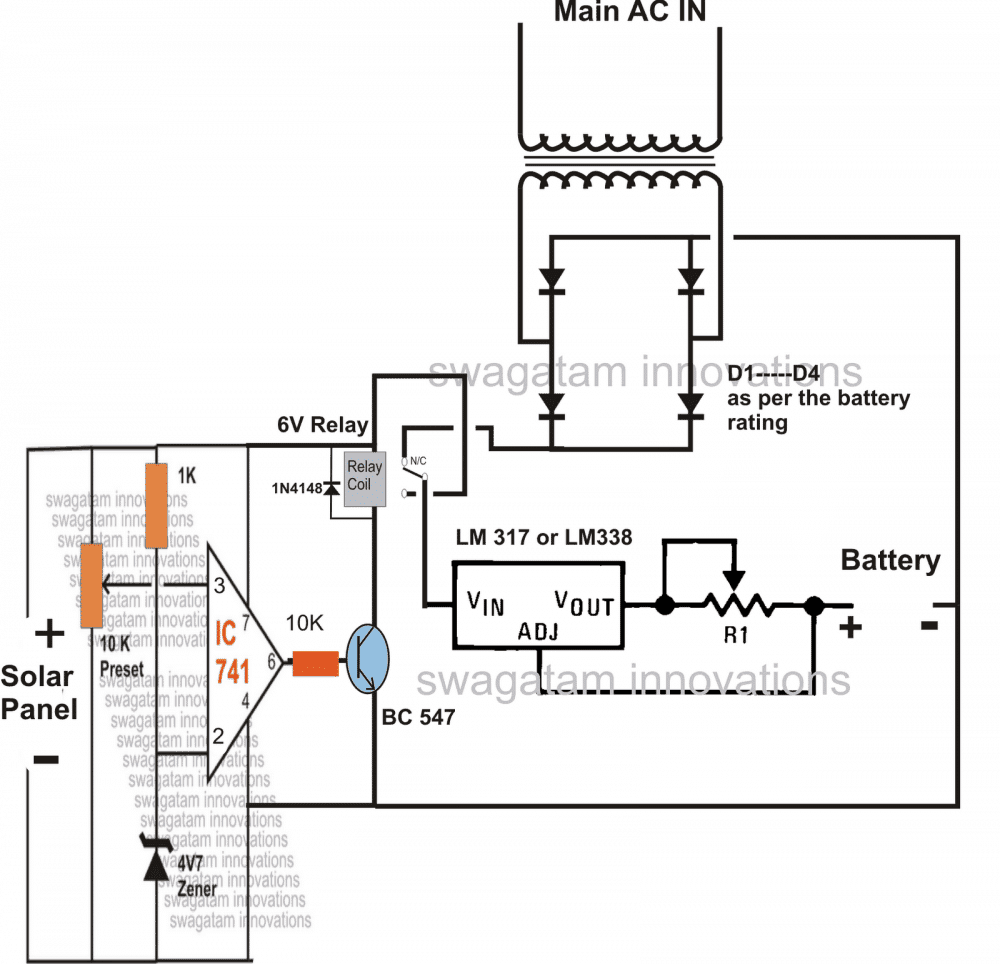
How the Circuit is Designed to Work
Looking at the proposed circuit diagram, we see three basic stages, on the left an IC 741 circuit, at the center a voltage regulator stage using IC LM317, while on the top an AC/DC adapter circuit.
The AC/DC adapter circuit is a simple rectified transformer power supply, designed for providing 7V DC as long as there's mains power available.
The IC317 circuit is a regulator circuit, configured for generating a constant current, 7 volts output to the 6V battery which is connected at the given points.
The pot with the LM317 IC may be adjusted to produce the required charging output for the particular battery.
The most important part of the circuit is the IC 741 stage, which is set up as a high voltage trigger circuit.
The associated preset is adjusted such that the relay activates when the solar panel voltage is above 7 volts.
The activation of the relay means the regulator circuit and the battery receive the voltage from the solar panel via the N/O contacts of the relay.
However, the moment the panel voltage drops below 7 volts, the relay switches OFF, connecting the DC adapter power with the regulator circuit, and now the battery starts getting charged through the AC/DC adapter voltage source.
The above results confirm perfect functioning of the entire circuit just as required by Mr. Baig.
R1 = Reference voltage/charging current = 1.25/Chg.Current
Solar Panel/Battery/Mains Changeover Relay Circuit
In this post I have explained a simple relay changeover circuit for managing a sustained power to the connected battery via a solar panel, and a mains operated SMPS power supply. The idea was requested by Ms Rina.
Technical Specifications
I would like to know how the circuit looks like for the problem that you have explained previously. But the application is little bit different.
There are three parameters:
The solar panel, The battery, And the AC/DC adapter. During day time the solar panel charges the battery and also stays connected to a 1hp air conditioner, pendaflour tube and a computer so that it can be lit through solar panel.
At night, all 3 appliances gets automatically connected to the battery.
And during overcast conditions or in absence of sunlight, if the battery voltage drops, the battery gets connected to the adapter so that it is able to get charged from the AC/DC source....
Thank you in advance Sir.
Rina
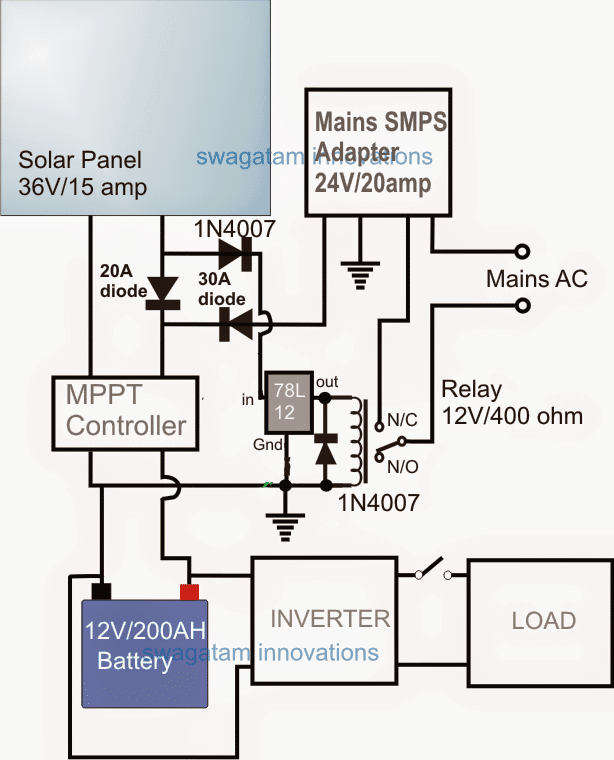
The Design
The proposed solar panel, battery and mains relay changeover circuit as shown above may be understood with the help of the following explanation:
Referring to the figure, we can see that the solar panel power is fed to a charger controller, preferably an MPPT circuit, and also to an SPDT relay coil (via a 78L12 voltage regulator)
This relay remains activated as long as the solar panel voltage is persistent during the day, and as soon as darkness falls, the relay contacts change over and switch the mains adapter voltage with the charger controller unit.
An inverter battery can be seen connected across the output of the charger controller, which is continuously charged through the controller either through the panel voltage or the Mains SMPS voltage, depending upon the day/night or overcast conditions.
The battery can also be seen directly and permanently connected to an associated inverter which is able to receive the battery power throughout the day and also during the night time.
However since the battery is consistently kept in the charging mode via the solar panel or the SMPS, its lower discharge level is never reached and the battery finds itself always in topped-up condition, and supplying a 24/7 power to the connected loads via the inverter output mains.
Solar Battery Charger, AC/DC Adapter Changeover
The enclosed circuit of an solar battery controller, AC/DC adapter automatic changeover circuit was requested by Mr.Juan. I have explained more about the request and the circuit from the below given discussions:
Discussing How to Build Solar Panel, DC Adapter Changeover Circuit
Hi Swagatam,
Your information and circuits are great.
But I want to ask for a special circuit.
I've a little solar panel with a solar/battery controller and a battery.
My load is connect to the load-pins of the controller, so when the battery voltage drops, the controller cuts off the output in load-pins immediately (from 11V-14V to 0V)
As hobby, I want to solar power from this system to a 12V led strip in my kitchen. But in case the light is on and the battery falls off, I want to autoswitch to a 220AC/12DC adapter that I have. So if my light is on, I will notice a little flick but nothing more, the light will be on all the time I want.
I don't want to "auto charge" battery with de AC/DC adapter in that case, because the main utility of my project is to use solar power.
I want to ask you several questions/circuits
1. I think I can't put together my controller ground and my AC/DC adapter ground, so I need a DPDT LATCH RELAY ("latch" in order not to waste lots of power from de battery system). And because of I can't put them together, I can't use the AC main switch of the kitchen to control all the system (I mean, the AC main switch of the kitchen will control the light, while the battery/controller powers the light either the AC/DC adapter)
2. What I want is that when my controller's load-pins output goes to 0V, the RELAY will turn to AC/DC power adapter. And when that output returns to 11-14V, the RELAY will turn to battery/controller system in order to waste "solar power" in my lights.
3. It doesn't mind if the relay is a single o dual coil, but the circuit has to be ultra low power consumption.
4. The ultra low power consumption is the reason for use a latch relay. It will only drain power when it has to activate o deactivate. I expect it not to activate never, so means that my solar system has a good battery capacity.
5. How can I control the light only with the AC main switch of the kitchen ?
Do I explain correctly ?
Before I knew about not to join grounds of the to systems (AC/DC adapter and controller output) I design this circuit with a simple SPDT normal relay. I have attached to you as a guide to understand this long post. but I suposse I can't do this way.
Hi Juan,
I am little confused, I couldn't understand the procedure correctly. There are three parameters:
The solar panel,
The battery,
And the AC/DC adapter.
I couldn't understand how you want to integrate these together.
According to me it should be like this:
During day time the solar panel charges the battery and also stays connected to the LED strip, so that it can be lit through solar panel.
At night, the LED strip gets automatically connected to the battery and uses the battery power for illumination.
And during overcast conditions or in absence of sunlight, if the battery voltage drops below 11v, the battery gets connected to the adapter so that it is able to get charged from the AC/DC source....
Is it that way you want??
First of all, thanks for your help.
Excuse me for my English.
The led strip is NOT always ON. It's a secondary light in my kitchen.
The solar panel is connected to a solar/charger/battery controller (it has 2 inputs and 1 output: solar panel, battery, and load).
The battery is also connected to the controller.
The load attached to the controller is the led strip.
What I want to do is give 2 power supplies to my led strip. The main supply is the one that comes from the controller (it's using solar power or a battery charged with solar power). The secondary supply is the one that comes from the AC/DC source.
I don't want to charge my battery with the AC/DC source (I've found some circuits for that).
I want to use the solar-battery-controller group to supply my led strip, but, just in case the controller cuts off the output (to protect the battery because of 3 or 4 four cloudy days or whatever), the led strip will be supplied by the AC/DC adapter.
Then, the next sunny day, the battery will be charged again with solar power (solar-battery-controller group).
I've to check the output of the controller, and when that output is 0V, I have to change to the AC/DC adapter. The battery remains "untouched".
There's also a handicap, the switch on the wall has to "control" the led strip (either supplied by controller, or by the ac/dc adaptor).(You will understand my previous post's pdf, the coil was energized by the AC/DC source, in order not to energized it if the wall switch is open)
NOTE: In future, I will also get a USB female in order to charge mobiles, and similar. (I've already get circuits to step down 12 V to 5 V). May be this USB female connector will have the same "AC/DC source as emergency" or not). but this doesn't matter now.
I got it now, the circuit will be very simple, I'll draw it and publish it in this blog as a new post, with the above discussions included....I'll inform you when it's posted....soon.
Thanks a lot,
Remember that is very important to drain a very "ultra low" power from the battery to make the circuit/relay/or whatever work. The solar system is little, so I can't have a constant drain of 30-50 mA, 24 hours per day. (that is because my first try was power the relay's coil directly with ac/dc source).
I will be using transistors instead of a relay, so the consumption will be negligible....
Done...here's the circuit requested by Mr.Juan, designed by me:
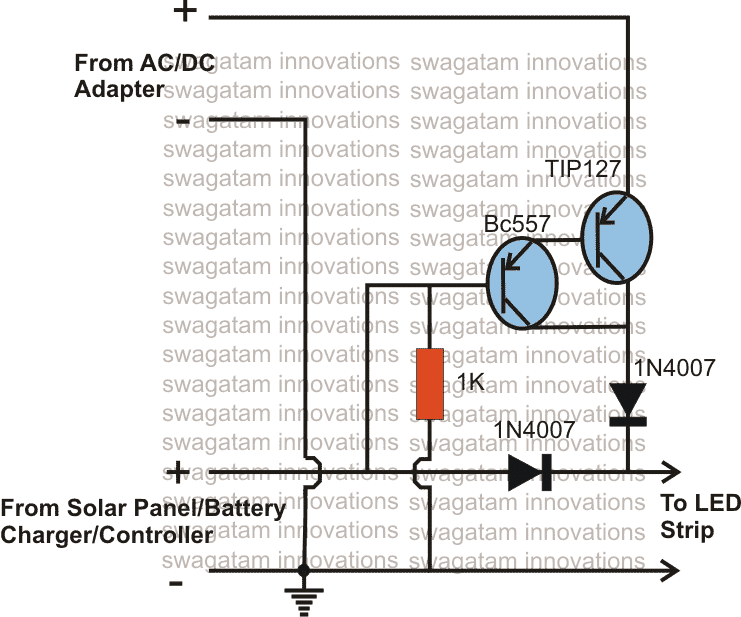
The following circuit goes in response to the added comment by Juan.
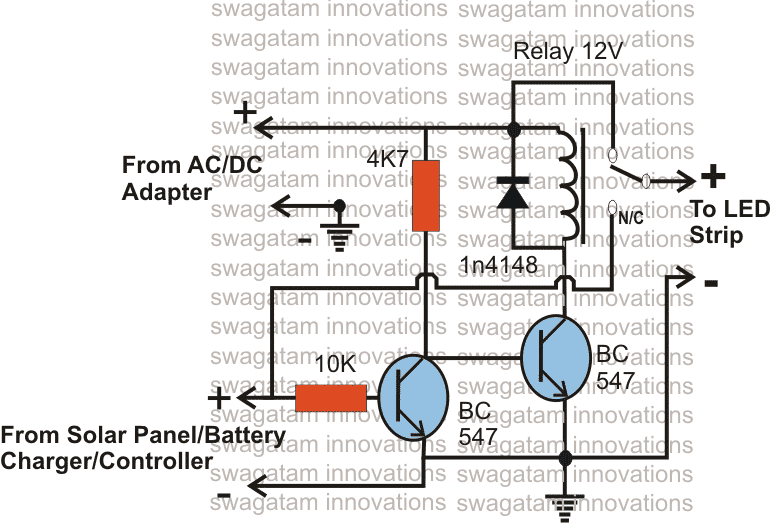
How the above circuits function:
In the upper circuit the transistor remains switched OFF by the +V from the solar panel during day, and switch ON during night via a the 1K resistor illuminating the LEDs. The diodes keep the voltages from the two sources isolated for correct functioning of the circuit
In the lower diagram, the left transistor conducts due to the presence of the solar voltage which grounds the base of the right transistor switching it off....during night the opposite takes place illuminating the LEds. The relay diode is a freewheeling diodes in order to protect the transistor from relay coil back emf.
the resistors are all 1/4 watt rated
For operating an AC load, the following design could be incorporated using a triac
